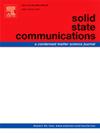掺杂稀土 Ce 的铜铝锰合金的弹性效应和磁性能
IF 2.1
4区 物理与天体物理
Q3 PHYSICS, CONDENSED MATTER
引用次数: 0
摘要
本研究系统研究了 Cu70Al20.5Mn9.5-xCex(x = 0、0.3、0.6、0.9)合金的弹性和磁性能。电阻-温度曲线(R-T)显示,合金的相变温度范围低于室温(约 230-272 K),并随着 Ce 含量的增加而升高。此外,热磁曲线(M-T)和等温磁化曲线(M - H)表明合金具有弱磁性。X 射线衍射图样显示,合金在室温下为单一的 β 相。应力-应变曲线显示,随着 Ce 含量的增加,合金的整体应变呈下降趋势,这表明 Ce 的加入会增加合金的压缩模量。弹性热稳定性测试表明,随着 Ce 含量的增加,合金的最大绝热温度变化先减小后增大。当 Ce 含量为 0.3 时,在 500 兆帕的卸载应力下,绝热温度变化为 7.4 K。温度-时间循环测试表明,Cu70Al20.5Mn9.2Ce0.3 具有良好的弹性热循环稳定性。本文章由计算机程序翻译,如有差异,请以英文原文为准。
Elastocaloric effect and magnetic properties of rare earth Ce-doped Cu-Al-Mn alloy
In this research, the elastocaloric and magnetic properties of Cu70Al20.5Mn9.5-xCex (x = 0, 0.3, 0.6, 0.9) alloy are systematically studied. The resistance-temperature curve (R-T) revealed that the phase transition temperature range of the alloy is below room temperature (about 230–272 K) and increases as the Ce content increases. In addition, the thermomagnetic curve (M-T) and isothermal magnetization curve (M − H) suggested that the alloy exhibits weak magnetism. The X-ray diffraction pattern shows that the alloy is a single β phase at room temperature. The stress-strain curve shows that with the increase of Ce content, the overall strain of the alloy tends to decrease, indicating that the addition of Ce will increase the compressive modulus of the alloy. The test of elastocaloric properties shows that the maximum adiabatic temperature change of the alloy initially decreases and then increases as the Ce content rises. When the Ce content is 0.3, it exhibits an adiabatic temperature change of 7.4 K under the stress unloading of 500 MPa. The temperature-time cycle test shows that Cu70Al20.5Mn9.2Ce0.3 has good elastocaloric cycle stability.
求助全文
通过发布文献求助,成功后即可免费获取论文全文。
去求助
来源期刊

Solid State Communications
物理-物理:凝聚态物理
CiteScore
3.40
自引率
4.80%
发文量
287
审稿时长
51 days
期刊介绍:
Solid State Communications is an international medium for the publication of short communications and original research articles on significant developments in condensed matter science, giving scientists immediate access to important, recently completed work. The journal publishes original experimental and theoretical research on the physical and chemical properties of solids and other condensed systems and also on their preparation. The submission of manuscripts reporting research on the basic physics of materials science and devices, as well as of state-of-the-art microstructures and nanostructures, is encouraged.
A coherent quantitative treatment emphasizing new physics is expected rather than a simple accumulation of experimental data. Consistent with these aims, the short communications should be kept concise and short, usually not longer than six printed pages. The number of figures and tables should also be kept to a minimum. Solid State Communications now also welcomes original research articles without length restrictions.
The Fast-Track section of Solid State Communications is the venue for very rapid publication of short communications on significant developments in condensed matter science. The goal is to offer the broad condensed matter community quick and immediate access to publish recently completed papers in research areas that are rapidly evolving and in which there are developments with great potential impact.
 求助内容:
求助内容: 应助结果提醒方式:
应助结果提醒方式:


